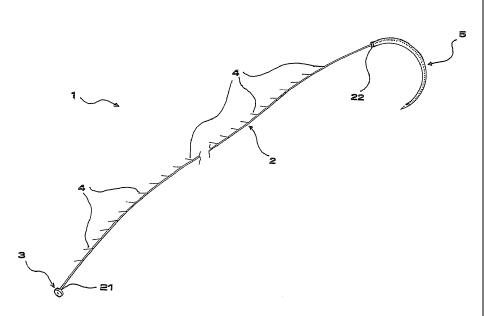Some of the information on this Web page has been provided by external sources. The Government of Canada is not responsible for the accuracy, reliability or currency of the information supplied by external sources. Users wishing to rely upon this information should consult directly with the source of the information. Content provided by external sources is not subject to official languages, privacy and accessibility requirements.
Any discrepancies in the text and image of the Claims and Abstract are due to differing posting times. Text of the Claims and Abstract are posted:
| (12) Patent: | (11) CA 2802020 |
|---|---|
| (54) English Title: | SUTURE THREAD |
| (54) French Title: | FIL DE SUTURE |
| Status: | Granted |
| (51) International Patent Classification (IPC): |
|
|---|---|
| (72) Inventors : |
|
| (73) Owners : |
|
| (71) Applicants : |
|
| (74) Agent: | BERESKIN & PARR LLP/S.E.N.C.R.L.,S.R.L. |
| (74) Associate agent: | |
| (45) Issued: | 2015-03-24 |
| (86) PCT Filing Date: | 2011-07-07 |
| (87) Open to Public Inspection: | 2012-01-12 |
| Examination requested: | 2012-12-07 |
| Availability of licence: | N/A |
| (25) Language of filing: | English |
| Patent Cooperation Treaty (PCT): | Yes |
|---|---|
| (86) PCT Filing Number: | PCT/IB2011/053016 |
| (87) International Publication Number: | WO2012/004758 |
| (85) National Entry: | 2012-12-07 |
| (30) Application Priority Data: | ||||||
|---|---|---|---|---|---|---|
|
A suture thread (1), comprising: - a thread-shaped main body (2) having spikes; and - a stopper cylinder (3) having a diameter enlarged with respect to the main body (2), which stopper cylinder (3) is arranged in correspondence of a longitudinal end (21) of the main body (2) to block said end in abutment against a tissue flap.
L'invention porte sur un fil de suture (1) comprenant : - un corps principal (2) en forme de fil ayant des pointes; et - un cylindre d'arrêt (3) ayant un diamètre élargi par rapport au corps principal (2), lequel cylindre d'arrêt (3) est disposé en correspondance avec une extrémité longitudinale (21) du corps principal (2) pour bloquer ladite extrémité en butée contre un lambeau de peau (Figure 1).
Note: Claims are shown in the official language in which they were submitted.
Note: Descriptions are shown in the official language in which they were submitted.

For a clearer understanding of the status of the application/patent presented on this page, the site Disclaimer , as well as the definitions for Patent , Administrative Status , Maintenance Fee and Payment History should be consulted.
| Title | Date |
|---|---|
| Forecasted Issue Date | 2015-03-24 |
| (86) PCT Filing Date | 2011-07-07 |
| (87) PCT Publication Date | 2012-01-12 |
| (85) National Entry | 2012-12-07 |
| Examination Requested | 2012-12-07 |
| (45) Issued | 2015-03-24 |
There is no abandonment history.
Last Payment of $263.14 was received on 2023-06-26
Upcoming maintenance fee amounts
| Description | Date | Amount |
|---|---|---|
| Next Payment if small entity fee | 2024-07-08 | $125.00 |
| Next Payment if standard fee | 2024-07-08 | $347.00 |
Note : If the full payment has not been received on or before the date indicated, a further fee may be required which may be one of the following
Patent fees are adjusted on the 1st of January every year. The amounts above are the current amounts if received by December 31 of the current year.
Please refer to the CIPO
Patent Fees
web page to see all current fee amounts.
| Fee Type | Anniversary Year | Due Date | Amount Paid | Paid Date |
|---|---|---|---|---|
| Request for Examination | $800.00 | 2012-12-07 | ||
| Application Fee | $400.00 | 2012-12-07 | ||
| Registration of a document - section 124 | $100.00 | 2013-02-26 | ||
| Maintenance Fee - Application - New Act | 2 | 2013-07-08 | $100.00 | 2013-06-19 |
| Maintenance Fee - Application - New Act | 3 | 2014-07-07 | $100.00 | 2014-06-18 |
| Final Fee | $300.00 | 2014-12-01 | ||
| Maintenance Fee - Patent - New Act | 4 | 2015-07-07 | $100.00 | 2015-06-29 |
| Maintenance Fee - Patent - New Act | 5 | 2016-07-07 | $200.00 | 2016-06-28 |
| Maintenance Fee - Patent - New Act | 6 | 2017-07-07 | $200.00 | 2017-07-03 |
| Maintenance Fee - Patent - New Act | 7 | 2018-07-09 | $200.00 | 2018-06-25 |
| Maintenance Fee - Patent - New Act | 8 | 2019-07-08 | $200.00 | 2019-06-24 |
| Maintenance Fee - Patent - New Act | 9 | 2020-07-07 | $200.00 | 2020-06-29 |
| Maintenance Fee - Patent - New Act | 10 | 2021-07-07 | $255.00 | 2021-06-28 |
| Maintenance Fee - Patent - New Act | 11 | 2022-07-07 | $254.49 | 2022-06-27 |
| Maintenance Fee - Patent - New Act | 12 | 2023-07-07 | $263.14 | 2023-06-26 |
Note: Records showing the ownership history in alphabetical order.
| Current Owners on Record |
|---|
| ASSUT EUROPE S.P.A. |
| Past Owners on Record |
|---|
| None |